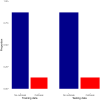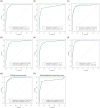Predicting malaria outbreak in The Gambia using machine learning techniques
- PMID: 38753678
- PMCID: PMC11098333
- DOI: 10.1371/journal.pone.0299386
Predicting malaria outbreak in The Gambia using machine learning techniques
Abstract
Malaria is the most common cause of death among the parasitic diseases. Malaria continues to pose a growing threat to the public health and economic growth of nations in the tropical and subtropical parts of the world. This study aims to address this challenge by developing a predictive model for malaria outbreaks in each district of The Gambia, leveraging historical meteorological data. To achieve this objective, we employ and compare the performance of eight machine learning algorithms, including C5.0 decision trees, artificial neural networks, k-nearest neighbors, support vector machines with linear and radial kernels, logistic regression, extreme gradient boosting, and random forests. The models are evaluated using 10-fold cross-validation during the training phase, repeated five times to ensure robust validation. Our findings reveal that extreme gradient boosting and decision trees exhibit the highest prediction accuracy on the testing set, achieving 93.3% accuracy, followed closely by random forests with 91.5% accuracy. In contrast, the support vector machine with a linear kernel performs less favorably, showing a prediction accuracy of 84.8% and underperforming in specificity analysis. Notably, the integration of both climatic and non-climatic features proves to be a crucial factor in accurately predicting malaria outbreaks in The Gambia.
Copyright: © 2024 Khan et al. This is an open access article distributed under the terms of the Creative Commons Attribution License, which permits unrestricted use, distribution, and reproduction in any medium, provided the original author and source are credited.
Conflict of interest statement
The authors have declared that no competing interests exist.
Figures






Similar articles
-
Machine Learning Hybrid Model for the Prediction of Chronic Kidney Disease.Comput Intell Neurosci. 2023 Mar 14;2023:9266889. doi: 10.1155/2023/9266889. eCollection 2023. Comput Intell Neurosci. 2023. PMID: 36959840 Free PMC article.
-
Dementia risk prediction in individuals with mild cognitive impairment: a comparison of Cox regression and machine learning models.BMC Med Res Methodol. 2022 Nov 2;22(1):284. doi: 10.1186/s12874-022-01754-y. BMC Med Res Methodol. 2022. PMID: 36324086 Free PMC article.
-
Optimizing neural networks for medical data sets: A case study on neonatal apnea prediction.Artif Intell Med. 2019 Jul;98:59-76. doi: 10.1016/j.artmed.2019.07.008. Epub 2019 Jul 25. Artif Intell Med. 2019. PMID: 31521253
-
Machine Learning and Deep Learning Techniques for Prediction and Diagnosis of Leptospirosis: Systematic Literature Review.JMIR Med Inform. 2025 May 29;13:e67859. doi: 10.2196/67859. JMIR Med Inform. 2025. PMID: 40440642 Free PMC article.
-
A Review of Machine Learning Algorithms for Biomedical Applications.Ann Biomed Eng. 2024 May;52(5):1159-1183. doi: 10.1007/s10439-024-03459-3. Epub 2024 Feb 21. Ann Biomed Eng. 2024. PMID: 38383870 Review.
Cited by
-
Strengthening health information systems and inherent statistical outputs for improved malaria control and interventions in western Kenya.Front Epidemiol. 2025 Jun 19;5:1591261. doi: 10.3389/fepid.2025.1591261. eCollection 2025. Front Epidemiol. 2025. PMID: 40612630 Free PMC article. Review.
-
Integrating machine learning and spatial clustering for malaria case prediction in Brazil's Legal Amazon.BMC Infect Dis. 2025 Jun 8;25(1):802. doi: 10.1186/s12879-025-11193-x. BMC Infect Dis. 2025. PMID: 40484933 Free PMC article.
-
Projection of future malaria prevalence in the upper river region of The Gambia.Malar J. 2025 Apr 3;24(1):108. doi: 10.1186/s12936-025-05348-z. Malar J. 2025. PMID: 40181373 Free PMC article.
-
AI-Driven Transcriptome Prediction in Human Pathology: From Molecular Insights to Clinical Applications.Biology (Basel). 2025 Jun 4;14(6):651. doi: 10.3390/biology14060651. Biology (Basel). 2025. PMID: 40563902 Free PMC article. Review.
References
-
- Mohammadkhani M, Khanjani N, Bakhtiari B, Tabatabai SM, Sheikhzadeh K. The relation between climatic factors and malaria incidence in Sistan and Baluchestan, Iran. Sage Open. 2019;9(3):2158244019864205. doi: 10.1177/2158244019864205 - DOI
MeSH terms
LinkOut - more resources
Full Text Sources
Medical
Miscellaneous

